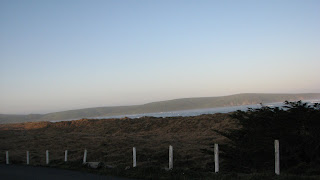
The
Santa Rosa Decoy Show was last weekend. This marked the third year I have attended this event. As expected, the coffee was hot and the homemade tuna salad sandwiches were delicious. The gentleman working the door was ready with a smile and a quick joke, "don't buy too many of those wooden ducks, now." I tried to heed his advice as I viewed the long table of shiny birds in perfect formation down the center aisle of the old vets' hall. Moving down the row, I stopped to admire and longingly hold a mint pair of Janson pintails nestled among their high priced brothers and sisters. It was then I realized two things: I wanted a pair of my own and that the only way I was going to get them was to make some sort of play that would get me into this decoy game. For the past two years I had attended the shows, but I was truly a spectator, no decoy card, nothing to trade. But I was prepared this year - a nice glossy business card proclaiming my status as a collector, and under my arm, a box which contained, what I hoped to be an irresistible lure to land my first trade: three unique decoys. If I had learned anything growing up with a decoy-collecting father, it was that mom liked the decoys a whole lot better when they were traded for, as opposed to, paid for. Knowing my wife would feel the same, I came to the end of the aisle where a well-known collector from Stockton had his display. We had met at the last two shows, and he always had some neat decoys. "What's in the box?" he asked. I tried to be cool, "some traders," I replied. I pull out a real straight
Jack Leach Pintail, and a miniature
Winterbottom preening Snow Goose made for the Manhattan Eddie Bauer store. I could tell he wasn't interested but he was nice and held the pintail, remarking how it reminded him of an
Ed Snyder. He then proceeded to introduce me to Ed Snyder, a real bayman and living legend! A great thrill, of course, but alas, no offers of a trade. I had one last decoy to show, a
David Rhodes yellowlegs. I did not hold much hope for this bird. Although it's beautiful and well-documented, it is geographically-challenged, as there is very little shorebird collecting on the west coast. But as I placed it on the table, with its blue ribbon around its neck, I felt new inspiration. "Well, no one around here collects shorebirds," he said, "but I have a friend who might like this, how much?" I couldnt believe it...it was going down! "$300," I blurted out, hoping not to mess it up. "You see anything here you like?" He gestured towards the bargain side of his table. I had noticed a hen pintail that was real nice. "Would you trade this?" "Sure," came the casual reply. And that was it, the trade was done. I was very pleased with the trade for two reasons: one - I now own a great pair of Joseph "Jake" Ferreira pintails (pictured above), Mr. Ferreira was regarded as one of the most stylish and innovative carvers in the San Francisco Bay , and two - I was pleased with myself for pulling it off, as I felt I had truly been initiated into the decoy world. This trade signaled to me that I was gaining knowledge and experience in this decoy game. And maybe with a bit of time and luck, a pair of Jansons may someday join the Ferreiras to roost.









